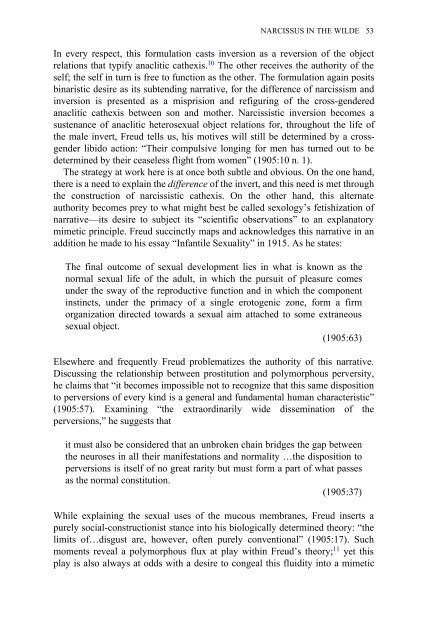Edited by Moe Meyer - Get a Free Blog
Edited by Moe Meyer - Get a Free Blog
Edited by Moe Meyer - Get a Free Blog
Create successful ePaper yourself
Turn your PDF publications into a flip-book with our unique Google optimized e-Paper software.
NARCISSUS IN THE WILDE 53<br />
In every respect, this formulation casts inversion as a reversion of the object<br />
relations that typify anaclitic cathexis. 10 The other receives the authority of the<br />
self; the self in turn is free to function as the other. The formulation again posits<br />
binaristic desire as its subtending narrative, for the difference of narcissism and<br />
inversion is presented as a misprision and refiguring of the cross-gendered<br />
anaclitic cathexis between son and mother. Narcissistic inversion becomes a<br />
sustenance of anaclitic heterosexual object relations for, throughout the life of<br />
the male invert, Freud tells us, his motives will still be determined <strong>by</strong> a crossgender<br />
libido action: “Their compulsive longing for men has turned out to be<br />
determined <strong>by</strong> their ceaseless flight from women” (1905:10 n. 1).<br />
The strategy at work here is at once both subtle and obvious. On the one hand,<br />
there is a need to explain the difference of the invert, and this need is met through<br />
the construction of narcissistic cathexis. On the other hand, this alternate<br />
authority becomes prey to what might best be called sexology’s fetishization of<br />
narrative—its desire to subject its “scientific observations” to an explanatory<br />
mimetic principle. Freud succinctly maps and acknowledges this narrative in an<br />
addition he made to his essay “Infantile Sexuality” in 1915. As he states:<br />
The final outcome of sexual development lies in what is known as the<br />
normal sexual life of the adult, in which the pursuit of pleasure comes<br />
under the sway of the reproductive function and in which the component<br />
instincts, under the primacy of a single erotogenic zone, form a firm<br />
organization directed towards a sexual aim attached to some extraneous<br />
sexual object.<br />
(1905:63)<br />
Elsewhere and frequently Freud problematizes the authority of this narrative.<br />
Discussing the relationship between prostitution and polymorphous perversity,<br />
he claims that “it becomes impossible not to recognize that this same disposition<br />
to perversions of every kind is a general and fundamental human characteristic”<br />
(1905:57). Examining “the extraordinarily wide dissemination of the<br />
perversions,” he suggests that<br />
it must also be considered that an unbroken chain bridges the gap between<br />
the neuroses in all their manifestations and normality …the disposition to<br />
perversions is itself of no great rarity but must form a part of what passes<br />
as the normal constitution.<br />
(1905:37)<br />
While explaining the sexual uses of the mucous membranes, Freud inserts a<br />
purely social-constructionist stance into his biologically determined theory: “the<br />
limits of…disgust are, however, often purely conventional” (1905:17). Such<br />
moments reveal a polymorphous flux at play within Freud’s theory; 11 yet this<br />
play is also always at odds with a desire to congeal this fluidity into a mimetic


